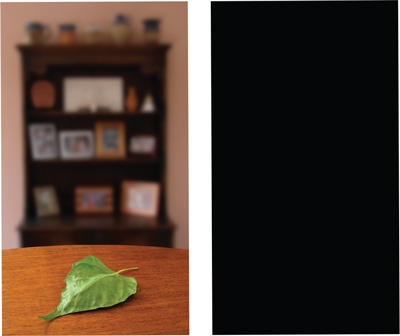How You Perceive Color
Understanding and remembering the relative nature of color is hugely important because it keeps us aware of the bigger picture, all the time. For a designer, the bigger picture might be the whole page rather than just one of the images on it; the whole project rather than just that single page; and the entire environment in which the work will exist rather than just the process that led up to its delivery to the client.
So, what color is a green leaf in a dark room? And why is this important?
Right now, you might feel that the leaf stays green, even in the dark. If so, see if the following example changes your mind.
If you think about it, the only things our eyes can see are color and shape. Both depend on light. Everything we see depends on the presence of light. So far we can all agree. But the color of what we see depends on the color of the light. A leaf only looks green if the light shining on it is white. It absorbs all the other colors and reflects green, and in our minds the green-ness and the leaf-ness somehow become one thing. But that is not accurate at all. If it were, then no matter what we did to it, the leaf would stay green. Yet if we shine a red light on it, there is no green to reflect at us, because red light does not contain a green element. Suddenly the leaf looks very dark, almost black. But the leaf itself has not changed at all. The only thing that has changed is the light, which bounces off the leaf as impartially as it does everything else within range.
There is no fundamental, inherent light source that is more valid than any other light source, despite what whole civilizations have thought about the sun until now. It is just that we are used to the sun hanging around up above us every day, and the lights we have in our houses are designed to be similar in color. And so we have come to feel the most comfortable with the way our world appears when it is illuminated with a whitish source of light. White light contains all the colors of the visible spectrum, so the objects it illuminates reflect the widest possible visible range. That is why things look more “real” to us when illuminated by white light than by a light of any other color. However, the fact that we prefer the way things look when illuminated by white light is just a habit based on how we are used to seeing things. A leaf is not inherently green. Or red. Or anything. Its color is relative, and depends on other equally relative factors for all its apparently inherent characteristics, just like everything else. In the case of the green leaf, if there is no light it is impossible to talk about its color, because the factor on which the appearance of color depends is not present (fig. 3.2).

3.2 If the “green leaf” example was confusing, try this. On the left: A green leaf. On the right: So what color is it now?
